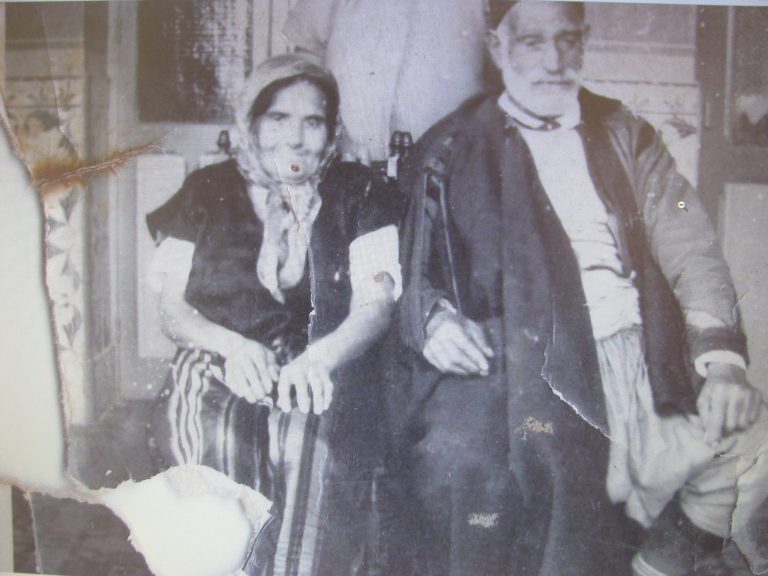I asked a friend of mine, Jessica Setbon, to tell me about her family history as Tunisian Jews. Her husband’s parents were both born and grew up in Tunis. She writes:
My husband Charly’s parents, Aimee and Serge Setbon, were both born and grew up in Tunis, the largest city in Tunisia. They were part of the large Jewish community there before immigrating to Marseille in 1959.
During WWII, Serge’s father was a train driver. He was killed when the British bombed his train as part of the battle against the Nazis in North Africa. Serge’s mother was widowed with three very young children. His body was never found and for seven years she lived as an aguna – a Jewish woman with no proof of her husband’s death. Technically she was still married. Finally, after his wedding ring was found, she was released from aguna status and she took a job as a ticket taker for the train company.
Aimee and Serge both recall hiding in bomb shelters during the war to escape British and Nazi bombings. Aimee grew up in a tiny apartment in the Jewish neighborhood. They were a large family of six kids (plus two that died in childhood), but there was always room for guests as well as a bedridden aunt. Her mother was well-known for her open door policy – everyone was welcome and the house was always full. She worked very hard to feed the family and their guests despite a very limited budget.
In Tunis, Serge recalls going outside for entertainment. People went to restaurants and cafes, as the climate was mild. In the summer, they enjoyed three months of vacation and many people rented a little house or room on the beach. On Sundays they would go fishing at the beach and buy fried doughnuts coated with melted sugar.
Many people were born there, many times living and dying in the same house. Serge lived with his mother, grandmother, two siblings and a divorced aunt in a three-room apartment on Avenue de Londre, which was not in the Jewish quarter but where many Jews lived. Of 16 apartments in their building, only one was Catholic. The others were all Jews. His mother worked full-time for the railroad. The grandmother cooked for the whole family.
Aimee and Serge both attended highly-disciplined, secular state schools, which were separated by gender. They went to school at 8:00 a.m., came home at 11:30 for lunch, returning to school at 1:30 until 4:00 or 5:00 p.m. The would sometimes stay the extra hour for study hall. On Thursday there was no school. Twice a week the boys went to Jewish Talmud Torah at the synagogue – Thursday and Sunday. The girls didn’t attend. They learned the basics of Judaism and how to keep a kosher home from their mothers. Aimee’s mother taught her basic halacha and kashrut laws such as meat/milk, and how to clean the herbs.
Aimee went to an Alliance Francaise school for high school, and the high school girls and boys studied Hebrew in the evenings.
Many Jews worked on Shabbat, most kept kosher – at least 80% and tried to keep Shabbat to some extent. Instances of intermarriage were low, it was disparaged and almost unknown. There were Jewish youth groups – Bnei Akiva and Dror Habonim. Each year the ZOA hosted a Purim party and took the kids to the cinema – a big luxury in those days.
Food Traditions
Many Tunisian recipes were based on inexpensive staples such as couscous, beans, and vegetables, as kosher meat was very expensive. Almost no milk products were used in their cuisine, so they had no halavi recipes.
They could tell the day of the week by the menu. Each day, lunch and dinner had its specific dishes with no variation. Serge says that this applied to the Italians and the Arabs in Tunis as well, about 80% of the population was eating the same thing at the same time! Apparently, the Arabs had something different on Shabbat.
Weekly Menu:
- Sunday- lunch: complet poisson – fried fish with fried eggplant and fried potatoes. Everything was fried in olive oil. Dinner was pasta with tomato sauce and barbecued meats.
- Monday – bsal ou loubia – bean/meat stew with onions
- Tuesday – couscous – because the bakery was closed on Tuesdays! This was typically served with fish or beans/meat, tripe, or pumpkin.
- Wednesday – ganaouia – okra with tomato sauce, green peas (dried) with spinach and ‘azbana (stuffed intestine)
- Thursday – hlallem – thin short homemade semolina pasta with mixed beans
- Friday night (Erev Shabbat) – couscous boulettes – couscous with breaded/fried meatballs and vegetable/meat soup.
- Shabbat lunch- dafina de blé (such as cholent, a meat stew that cooked all night long), nikitouche (homemade semolina pasta in chicken/meat soup) that also cooked all night.
The Jewish holidays also had set menus. If you reserved a hall for a bar mitzvah or wedding, you knew the menu in advance because it was always the same. For a wedding, the henna* party was followed by a fancy meal. The wedding ceremony was held in synagogue. Then candied almonds were handed out at the door and everyone went home. They didn’t have another big dinner like today.
Party Menu:
- Brique a l’oeuf (thin filo pastry with an egg wrapped inside and deep fried)
- fèvres (fava beans)
- turnips/carrots in vinegar
- fish in sauce
- pkaela (stew of fried spinach with beans/meat)
- Cakes fried and dipped in caramelized sugar.
- More formal events included a pièce montée- a tall tower of pastries coated with caramelized sugar
At the time, refrigeration was not yet available in Tunis, so each day the grandmother or mother went to buy what was needed. On Friday, the Jews bought everything in advance for two days and made dafina (slow cooked stew) because they didn’t cook on Shabbat.
There was no gas and they cooked over a charcoal fire called a kanun. Serge’s grandmother rose early in the morning and lit the fire to make coffee and start breakfast. On Friday afternoons they placed the dafina on top of the fire and covered it with blankets. Sometimes the fire went out and it got cold, and sometimes it burned… It wasn’t easy.
In the kitchen, they had a stone fireplace. The charcoal was placed on top of the pot and the cinders fell beneath. Before Shabbat they would light two or three fires, at times filling the whole with smoke or going out altogether. They put eggs inside the pot and they cooked, turning dark brown. Or they cooked onions and ate them with vinegar and salt.
In 1959, Tunis became independent. The Arabs took power and Serge was afraid he would be for the army. There were many disturbances, with bombings and fires in the streets. The new government set a curfew, everyone was to stay home from 9:00 p.m. – 6:00 a.m. So Serge left Tunis at the age of 21 and went to Marseille. Serge was the first of the family to leave and was initially planning on moving to Canada. But he and Aimee were planning to marry, and Aimee was reluctant to move so far from her family. Aimee joined Serge one year later and they were married. Eventually, the rest of the family followed.
Serge did not have a French passport. Because his father was a war victim, he was given a special status by the veterans organization – “Anciens Combattants.” He showed his papers and they gave him an identity card good for ten years. They offered him French citizenship but he refused. He didn’t want to be drafted for the Algerian war or others. However, he was required to do a few days in the French army.
Following in her mother’s shoes, Aimee graciously hosted her relatives as they all gradually immigrated to Marseille. They remained until they were able to support themselves. She and Serge lived in a small apartment, but they found room and extra food for whoever needed a place. Guests would sleep in the living room and Serge’s mother also immigrated, living with them for many years. As a result, Charly grew up surrounded by family. His mother, who didn’t work outside the home, provided two big, delicious meals daily.
When Aimee left Tunis in 1960 to join Serge in Marseille, Aimee’s mother gave her seven gold bracelets. This was a Tunisian tradition called la semaine (“the week”), all the women (Jewish, Arab, Italian) received seven gold bracelets after they married. This was for decoration but also was a way of keeping money as there were no savings banks. Her mother Rachel lost one of the set. A year after Aimee was married, she returned to Tunis for a family bar mitzvah. She told her mother she was pregnant. Her mother gave her the six bracelets believing it was more important for Aimee to have them as a young bride. Aimee returned to Marseille and her mother died before Aimee gave birth. They named the baby after her. Eventually Serge gave her a seventh bracelet to complete the set.
Aimee says that her father and mother were distant cousins. Her father had actually wanted to marry Rachel’s younger sister Leah. But Rachel was older and the family convinced him to marry Rachel. When her father died in Marseille in 1990, Aimee and her siblings brought his body to Israel for burial in the Holy Land. Leah’s son Jacky was living in Israel at the time, and purchased twin burial plots for Leah and his father. Leah had died a few years earlier in France, and Jacky brought her to Israel to bury her in one of the plots. But then Jacky fell on hard times, and so when his father died in France, he was buried there because he couldn’t afford to bring the body to Israel. When Aimee’s father died and Jacky heard they were bringing his body to Israel, he offered them the plot next to Leah. By serendipity, Aimee’s father wound up being buried next to his first love, Leah, in the family plot in Israel.
*Henna gifts were seven pairs of shoes (one for each day of the week) and gold jewelry.
Source: Harrisa.com (in French)
—————–
As a complement to Jessica’s article, we’re providing a brief history of Jews in Tunisia.
Jews have been living in Tunisia for thousands of years, with stories dating back before the destruction of the First Temple. As a result of the Judeo-Roman War, a large number of Jews were sent to Mauritania, and from there many of them settled in Tunisia. Under Roman rule, the Jews were required to pay a capitation tax of 2 shekels and lived in tribes and clans. These settlers worked in agriculture, cattle-raising, and trade. In the 7th century, a wave of Spanish immigrants fleeing from persecution arrived, and the Jewish population grew.
In 788, Imam Idris sought to liberate Mauritania of Baghdad rule, Tunisian Jews fought in his army. They withdrew, however, because they were reluctant to fight the fellow Jews in Mauritania, as well as against Idris actions against Jewish women. Idris retaliated by attacking the Jews, but this was unsuccessful and peace was concluded on the condition that Jews pay a capitation tax and provide an annual number of virgins for Idris’ harem. In 793, Idris was poisoned and in the year 800 the Aghlabite dynasty took over the region. This was a brighter time for the Jews, as they had gained some political influence. As new dynasties took over, however, Jews continued to be persecuted in various ways, such as forceful conversion and making them wear special garb.
Under the Hafsite dynasty, established in 1236, Jews were able to practice their religion freely and had communities in Mehdia, Kalaa, Gerba, and Tunis. In Tunis, however, they were not allowed to settle inside the city until Sidi Mahrez, using his political influence, obtained the right for Jews to settle in a special quarter called the “Hira.” After the defeat of Saint Louis of France, Kairwan and Hammat were declared holy and the Jews and Christians living there were forced to leave or convert. They were forbidden to pass through these cities at night, and could only appear during the day with special permission.
During the Spanish Inquisition, very few Jews came to Tunisia from Spain and Portugal – the majority went to Algeria and Morocco instead. This was due to the harsh conditions Jews were experiencing in Tunisia at the time. They lacked rabbis and scholars, and were forced to pay a series of taxes: a communal tax, capitation tax, and general tax. Despite this, Jews were controlling much of the commerce in the country. During the Spanish occupation of the Tunisian coasts in 1535-74, the Jewish communities in the seaports suffered greatly under harsh Turkish rule.
The condition of Jews living in Tunisia steadily improved as European powers intervened, seeking to better conditions for both Christians and Jews
“With all the apparent oppression, the Jews are the leading men; they are in Barbary the principal mechanics, they are at the head of the custom-house, they farm the revenues; the exportation of various articles, and the monopoly of various merchandise, are secured to them by purchase, they control the mint and regulate the coinage of money, they keep the bey’s jewels and valuable articles, and are his treasurers, secretaries, and interpreters; the little known of arts, science, and medicine is confined to the Jews. . . . If a Jew commits a crime, if the punishment affects his life, these people, so national, always purchase his pardon; the disgrace of one affects the whole community; they are ever in the presence of the bey, every minister has two or three Jewish agents, and when they unite to attain an object, it cannot be prevented. These people, then, whatever may be said of their oppression, possess a very controlling influence, their friendship is worthy of being preserved by public functionaries, and their opposition is to be dreaded.” – Mordecai M. Noah (“Travels in Europe and Africa,” p. 308, New York, 1819)
Jews had a period of prosperity in the 19th century under the rule of Ahmad Bey, and his successor, Mohammed Bey, sought to make things better by abolishing rules imposed on them. However, after the execution of a Jew named Batto Sfoz, there was unrest amongst Jews and Christians alike and they sent a deputation to Napoleon III to intervene. The French government pushed Bey to issue a constitution giving Jews equal rights. Many Jews lived in Tunis at this time, being one sixth of the population. Jews lived in relative peace due to the country’s fear of foreign intervention, but a revolution in 1864 brought on a great deal of suffering for the Jewish communities, especially those in Sfax.
In November 1942, Tunisia was home to more than 100,000 Jews. Nazi Germany invaded the country, making Tunisia the only Arab country under direct Nazi occupation during World War II. Jews were forced to wear yellow Star of David badges, were subject to various fines, and had their property confiscated. Over 5,000 were sent to forced labor camps, where 46 are known to have died. Another 160 were sent to death camps. During this time, Khaled Abdelwahhab, a wealthy Tunisian landowner, helped rescue over two-dozen Jews from the town of Mahdia, where German soldiers arrived to expel Jewish families and turn their homes into barracks. Abdelwahhab housed the group at his farm until it was safe for them to return. He was the first Arab honored as a Righteous Gentile by the Holocaust remembrance authority Yad Vashem.
The Jewish community in Tunisia is now welcomed by the government, but anti-Semitic attacks have pressured Jews to emigrate to France and Israel. Today, there are about 2,000 Jews living in Tunisia, with the majority in Tunis and the island of Djerba.
The island of Djerba is home to a thriving Jewish community that lives, side by side, with its Muslim neighbors in peace. The community living there is conservative, practicing traditions dating back centuries. They have many small businesses, including gold and silversmiths.
Every year, tourists from around the world visit its famous El Ghriba synagogue. Although the building has only been there for about a century, the site is believed to have had a synagogue on it for 1,900 years. Lag B’Omer is a holiday that attracts many to the site. It’s the 33rd day of Omer, a day of semi-mourning on the Jewish calendar. Many parties are held, as well as a large festival.
Peak Population of Jews in Tunisia: 105,000 in 1948
Population of Jews in Tunisia: 1,700 in 2017
Further Reading:
Justice for Jews from Arab Countries is an organization dedicated to representing Jews from Arab countries and preserving the legacy of those Jewish communities. They collect and house personal testimonies and historical accounts of Jews from Arab countries. Justice for Jews from Arab Countries provides education programs and resources so the public can learn about the history of the Jewish people in Arab countries. You can read their account of the history of the Jews in Tunisia here.




